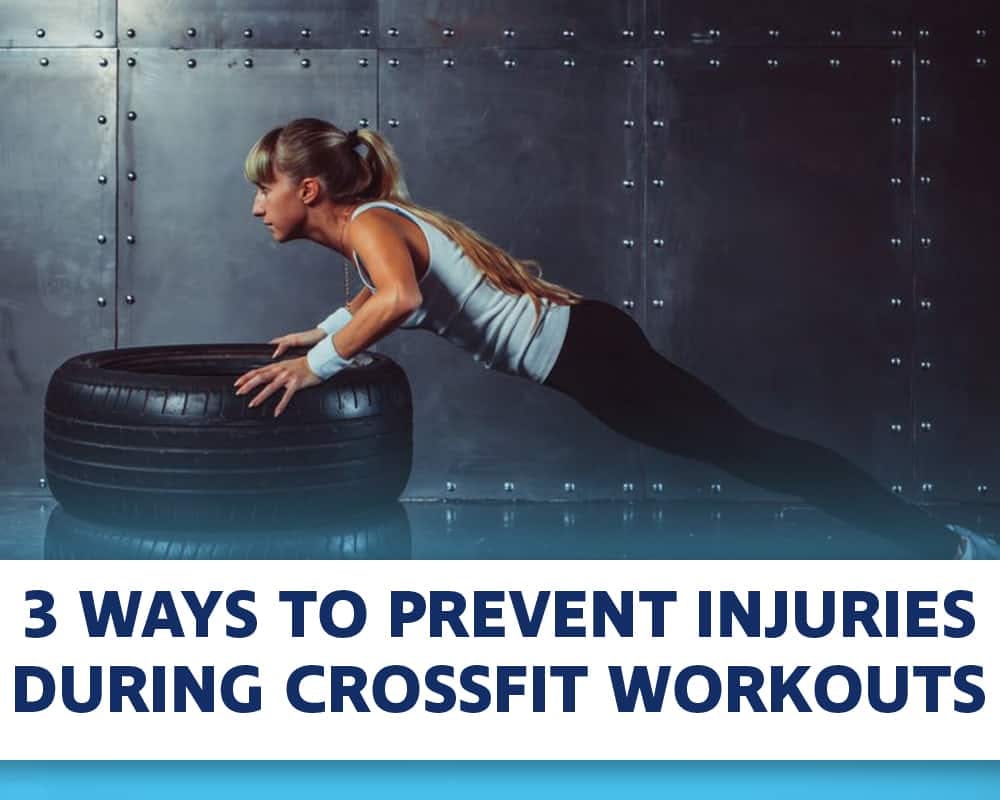- Blog
3 Ways to Prevent Injuries During CrossFit Workouts
Posted on 12-01-2025 in CrossFit by Dr. Chris O'Grady

Posted on 12-01-2025 in CrossFit by Dr. Chris O'Grady
High-intensity workouts that vary day-to-day challenge CrossFit athletes as they train against a running clock.
Power cleans, one-legged squats, pull-ups, rope climbs and handstand walks are just a few exercises that can be found in various CrossFit workouts of the day (WODs). These workouts combine aspects of gymnastics, weightlifting, running and rowing, among other activities.
Taking precautions can put CrossFitters in a better position to avoid strains, sprains, tears and other serious injuries. Here’s how:
Find the right place and instructor
Finding a reputable CrossFit gym, or “box,” with well-trained instructors is the first step to preventing injuries. In fact, when selecting a CrossFit box, it’s just as important to check out the experience and skill levels of the trainers as it is to look at the facility and equipment.
CrossFit certifies its trainers, beginning with a “level one” certificate course. Certified CrossFit trainers and coaches can monitor and assess an athlete’s progress. They will scale weights or movements based on the athlete’s specific needs and goals. They can also train athletes to work out safely by taking previous injuries and other issues into account. Find a box where safety and education of the staff and members are clearly high priorities.
Pay Attention to Form
Lifting weights, squatting, lunging and other CrossFit workouts are most effective and safe with the correct form. This is especially important in a program where high intensity is the goal.
Don’t let pride get in the way of asking a trainer for tips on how to improve technique. Taking time to check form with a trainer ensures your muscles, joints and other musculoskeletal components are in the ideal position for taking on an added load and performing specific movements. This is vital not only to improve fitness outcomes but also critically important to avoid pitfalls that lead to strain injuries.
Don’t sacrifice form for reps. Even seasoned athletes will lose form as they fatigue. When you recognize you are losing form, you can make a better decision as to whether it is safe to push out another rep or to stop and live for the next workout of the day.
Warm up and stretch out
This is common advice for any physical exercise, but unfortunately, it’s a step plenty of athletes overlook. Others may think they’re warming up properly, but they’re not warming up long enough, or they’re warming up the wrong muscle groups.
Without a proper warmup, your body isn’t prepared for the increased load and strain that’s about to be placed on it. Muscle fibers are cold and inflexible, and circulation hasn’t been ramped up to help your body get rid of toxins released during exercise. And that means you’re much more likely to become injured.
Stretching, running in place or performing low-impact aerobic activity before starting a routine can help get your muscles and circulatory system up to speed so your body performs better and can help avoid injuries.
With intense training comes the risk of injury no matter what sport or workout an athlete participates in, but by being mindful of these three tips, you will be put yourself in the best position to stay healthy and keep active with CrossFit and beyond

Musculoskeletal ultrasound imaging offers orthopaedic patients safe, painless, and real-time imaging, without any harmful ionizing radiation or the need for uncomfortable positioning. As the first sports medicine physician in the region to utilize ultrasound for diagnostic and therapeutic purposes, Dr. Josh Hackel’s commitment to innovation has improved the accessibility of care for his patients.

According to the American Academy of Orthopaedic Surgeons, approximately 2 million older Americans sustain fractures yearly due to weak bones. By 2025, that number is predicted to rise to 3 million fractures annually. At North Florida Bone & Joint Specialists, we recognize the importance of maintaining strong bones, particularly as you age. In honor of Healthy Aging Month, the following tips can help you maintain, and even improve, your bone strength:

We see our share of broken bones as an orthopaedic and sports medicine practice. From the high school baseball player who collided with first base a little too hard to the avid DIY’er who took a tumble from an unsecured ladder and everything in between, we’ve seen it all. As we age, we also gradually lose bone mass, which occurs as small amounts of healthy bone are absorbed into your body as small amounts are replaced. When more bone is absorbed than is replaced, the density (bone mass) is reduced. Osteoporosis develops when the bone is no longer replaced as quickly as it is removed, and over time, it causes the bone to become progressively weaker, increasing the risk that it may break.